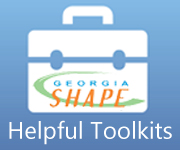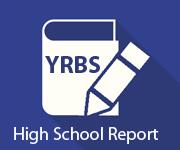Can my child “fail” the FITNESSGRAM assessment?
No. FITNESSGRAM is a tool to help your child determine his/her fitness needs and guides him/her in planning a personalized physical activity program. The assessment will not affect your child’s grades in any way.
Can students fail the fitness assessment?
No. Students cannot fail, and are not compared to other students. FITNESSGRAM generates reports for parents and guardians, showing whether their child falls within the "healthy fitness zone" in each area. The report also provides recommendations for improvement.
Does collecting height and weight as part of an overall fitness assessment put children at risk for developing eating disorders?
No. The professional instruction provided by Georgia’s fitness assessment teaches that students be weighed-in backwards to avoid any emphasis on weight as a number. Even the student is not informed of their weight to eliminate being pressured by other students to share their results. Body composition is only one component of an overall assessment which focuses on health rather than numbers. The report indicates if a child is above or below the healthy fitness zone, provides recommendations, and explains the limitations of BMI.
How will a fitness assessment benefit parents and caregivers?
Parents will receive a report generated by the FITNESSGRAM software detailing their child’s health related fitness levels, along with personalized tips and suggestions that can help in planning an individualized fitness plan. An accurate assessment of physical fitness is one component of a comprehensive physical education curriculum that incorporates health-related fitness education. The report provides a way for teachers (and parents) to teach children about the importance of being active and fit throughout their life.
How will data collected from fitness testing in Georgia be used to improve health and fitness?
Fitness testing alone will not make children healthier. Through fitness assessment, the program provides personal information that can help parents and children make informed decisions. Longer term, consistent data collection on health-related fitness standards will establish baseline data, provide an opportunity to track and monitor trends, and enable the development of strategies to improve child health and fitness that are measurable and result-driven.
What are the benefits of being physically fit?
Physical fitness has been shown to be important for health and quality of life. Assessments of physical fitness provide an effective way to evaluate overall physical condition and potential risk for negative health outcomes. Physical fitness is also more easily assessed than physical activity since it doesn't vary on a day-to-day basis. It is important to note that physical fitness is also influenced by factors that are out of a person's control (for example, genetics). While not everyone can be an elite athlete, most people can achieve healthy levels of fitness by performing the recommended amounts of physical activity.
What are the benefits for participating schools?
When schools participate in the SHAPE initiative, their physical education teachers will receive professional training about testing protocol and data entry, and they will be supplied with the equipment, software and technical support needed to conduct the assessment in their school. Participants will also be eligible for the Governor’s award and recognition program, which will provide exciting incentives for teachers and schools.
What are the FITNESSGRAM assessment items?
There are five assessment items:
PACER or One-Mile Run (measures aerobic capacity)
Push-Ups (measures upper body muscular strength/endurance)
Curl-Ups (measures abdominal muscular strength/endurance)
Back-Saver Sit and Reach (measures flexibility)
Body Mass Index (measures body composition: appropriateness of weight relative to height)
What can my child do to prepare for the fitness assessment?
Make sure your child actively plays or moves at least 60 minutes at least five days during the week. Your child can walk, jog, play tennis, play racquetball, or participate in any physical activity he/she enjoys.
Have your child do strength training activities such as sit-ups, push-ups, modified push-ups or climbing activities 2-3 days each week. Have your child begin doing as many repetitions as possible and have them try to increase repetitions gradually.
Make sure your child eats a healthy diet by including more fruits and vegetables and reducing fats and sugars.
Tell your child to ask a physical education teacher or coach at his/her school for specific tips on ways he/she can prepare not only for the FITNESSGRAM assessment, but for a lifetime of good overall health.
What does the current picture of physical activity and wellness look like for Georgia’s children?
Our state has the second highest rate of obese children in the country. Only five in nine (55 percent) middle school students and four in nine (44 percent) high school students meet the Centers for Disease Control and Prevention (CDC) requirements for recommended physical activity. More than two in five of Georgia’s middle school students (44 percent) and high school students (43 percent) watch TV for three or more hours on a school day. Obese children are three times more likely to be hospitalized than children who are not obese. Obesity-related healthcare costs reach an estimated $2.1 billion a year.
What is Georgia SHAPE?
Georgia Shape is the Governor’s statewide, multi-agency and multi-dimensional initiative that brings together governmental, philanthropic, academic and business communities to address childhood (0-18) obesity in Georgia. Over the next ten years Georgia Shape will work towards increasing the number of students in the Healthy Fitness Zone for Body Mass Index by ten percent. Other objectives set forth by the Governor and Georgia Shape include reaching disparate populations, increasing the aerobic capacity measure of Georgia’s youth, increasing the breast feeding rate across Georgia, and increasing the number of early care centers that excel in nutrition and physical activity measures.
Georgia Shape grew from the S.H.A.P.E (School Health and Physical Education) mandate passed in 2009 requiring all students in grades 1st-12th enrolled in physical education to participate in the Fitnessgram fitness test (which was recently named the national standardized fitness assessment). Georgia Shape, the Georgia Department of Education, Children’s Healthcare of Atlanta, and HealthMPowers worked together to effectively train physical educators across the state how to successfully implement Fitnessgram in their school setting. Training is still available through webinars conducted as needed.
Georgia Shape, as it is known today, was launched in 2012 by the Georgia Department of Public Health (GDPH), and includes strategies for addressing obesity from birth through age 18 involving statewide, coordinated efforts with targeted communication strategies and multiple partnerships among other state government agencies, private foundations, healthcare providers, professional athletic teams, and private companies. Efforts focus on schools, communities, child care centers, government and policy agencies, businesses, hospitals, and medical practices.
What mechanism and criteria are being used for testing?
The Georgia Department of Education selected FITNESSGRAM, a comprehensive health-related physical fitness and activity assessment and computerized reporting system developed by The Cooper Institute. This system includes a complete battery of health-related fitness items that are scored using age and gender specific standards based on how fit children need to be for good health. The assessment includes body composition, abdominal strength, flexibility, and endurance.
Who is the Georgia SHAPE Partnership?
In 2010, the Governor’s Office recognized the opportunity to bring together the Georgia SHAPE Partnership, a group of government, education, healthcare and non-profit leaders to collaborate on this statewide effort. These partners support funding, training, data centralization, reward/recognition, and a sustainable plan for long-term results. Please visit the partnership tab for more information about the groups contributing to this effort.
Why include BMI data?
Baseline data is the foundation of measurable outcomes. Though BMI is the current standard to measure body composition, Georgia has no data source that provides state or local-level data for all school age children. Without data, it is difficult to evaluate the impact of obesity prevention and intervention strategies.
Why is assessing fitness important to my child?
The FITNESSGRAM physical fitness assessment is based not on athletic ability, but on good health. No matter what your child’s career path, he/she will live a happier, more productive life if he/she is healthy – and physical fitness is vital to overall health. FITNESSGRAM provides accurate and reliable information about your child’s physical condition and how it can be improved.
Why should a physical education assessment be required in schools?
Standardized assessments are useful tools for all school subjects to monitor trends and changes, collect data, and improve programs, curriculum and policy. Just like academic testing, standardized assessments for physical education provide these same benefits and opportunities for improvement.
Will BMI collection increase bullying or teasing of peers?
Research does not indicate that BMI testing or fitness assessments put children at a heightened risk for bullying. Regardless, Georgia is taking additional precautions to avoid the possibility. Weight measurements are taken in a private setting, and viewed only by the teacher conducting the assessment. The teacher can set a tone of acceptance for different body types and acknowledge the important genetic contribution to obesity. Using FITNESSGRAM can help young children set realistic standards for their body and avoid the overemphasis on leanness that is often displayed by our culture.
Will my child’s results be compared to other students?
No. FITNESSGRAM uses the Healthy Fitness Zone (HFZ) to determine your child’s overall physical fitness. HFZs are not based on class averages or any other peer comparisons. The standards are set specifically for boys and girls of different ages using the best available research. If your child’s score falls within the HFZ, it means your child has achieved the recommended level of fitness for his/her age. If your child’s score falls below the HFZ, he/she should engage in activities that will help him/her improve.
Will my child’s scores be posted or be made public?
No.
Will student privacy be protected?
Absolutely. Individual student data will only be shared with the child's parent or guardian.
Sources: Georgia Department of Community Health, Division of Public Health and F as in Fat: How Obesity Policies Are Failing in America 2009, by the Trust for America’s Health and the Robert Wood Johnson Foundation.



